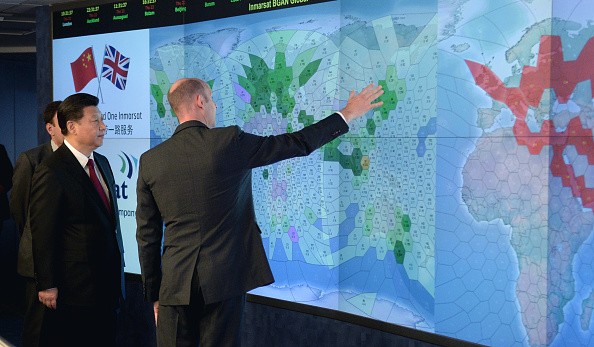China to Send 3 Satellites to Space for Gravitational Wave Research Project
| Iesha javed | | Mar 22, 2016 06:49 AM EDT |
(Photo : Anthony Devlin - WPA Pool/Getty Images)) Being less expensive, the second Chinese endeavor towards studying gravitational waves will have certain limitations with regards to detection and thus will only target a particular group of stars for observation.
China laid the foundation for infrastructure of its "Tianqin" gravitational wave research project at the coastal city of Zhuhai on Sunday. This is the second Chinese proposal initiated for the exploration of gravitational waves in addition to the highly ambitious and expensive "Taiji" program.
Like Us on Facebook
The Guangdong-based Sun Yat-Sen University revealed its plan of studying the gravitational waves at a symposium on February 21 and estimated the completion of the program in about 15 to 20 years. The program aims to launch three synchronized satellites, forming an equilateral triangle to detect and observe the gravitational waves, as per Li Miao, Dean of the university's Institute of Astronomy and Space Science.
The Tianqin program is headed by Luo Jun, a physicist at the Sun Yat-Sen University. It is said to be a low-key project in terms of resources required and expenses incurred with an estimated cost of 15 billion yuan (2.3 billion U.S. dollars).
Being less expensive, the second Chinese endeavor towards studying gravitational waves will have certain limitations with regards to detection and thus will only target a particular group of stars for observation.
Situated in the southern coastal city of Zhuhai, the research building of the Tianqin project has an impressive infrastructure, spanning over 30,000 square-meters possessing a 10,000 square-meter ultra-quiet cave laboratory and a 5,000 square-meter observation station.
According to Gerhard Heinzel, an eLISA (Evolved Laser Interferometer Space Antenna) physicist, these research programs are too vast in terms of costs and resources and might be difficult for a single country to handle. Chinese researchers from the Taiji program have also hinted at the possibility of a merger with European programs like eLISA.
Wu Ji, Director-General of the Chinese Academy of Sciences' National Space Science Center, said that the two Chinese projects should be integrated, keeping in mind the cost constraints. However, no concrete information regarding a merger with either European or Chinese programs has been provided.
With the initiation of infrastructure for the Tianqin research program, it is only a matter of time before these questions are answered.
Tagschina, China Scientists, China technology, China water project, gravitational waves, gravitational wave astronomy black holes colliding merging, gravitational attraction, ELISA Test, The Chinese Academy of Sciences, Stars, space observatory
©2015 Chinatopix All rights reserved. Do not reproduce without permission
EDITOR'S PICKS
-

Did the Trump administration just announce plans for a trade war with ‘hostile’ China and Russia?
-

US Senate passes Taiwan travel bill slammed by China
-

As Yan Sihong’s family grieves, here are other Chinese students who went missing abroad. Some have never been found
-

Beijing blasts Western critics who ‘smear China’ with the term sharp power
-

China Envoy Seeks to Defuse Tensions With U.S. as a Trade War Brews
-

Singapore's Deputy PM Provides Bitcoin Vote of Confidence Amid China's Blanket Bans
-

China warns investors over risks in overseas virtual currency trading
-

Chinese government most trustworthy: survey
-

Kashima Antlers On Course For Back-To-Back Titles
MOST POPULAR
LATEST NEWS
Zhou Yongkang: China's Former Security Chief Sentenced to Life in Prison

China's former Chief of the Ministry of Public Security, Zhou Yongkang, has been given a life sentence after he was found guilty of abusing his office, bribery and deliberately ... Full Article
TRENDING STORY

China Pork Prices Expected to Stabilize As The Supplies Recover

Elephone P9000 Smartphone is now on Sale on Amazon India

There's a Big Chance Cliffhangers Won't Still Be Resolved When Grey's Anatomy Season 13 Returns

Supreme Court Ruled on Samsung vs Apple Dispute for Patent Infringement

Microsoft Surface Pro 5 Rumors and Release Date: What is the Latest?












